Caribbeanization of North America: A Historical Overview
VerifiedAdded on 2021/05/31
|9
|2115
|53
Essay
AI Summary
This essay provides a comprehensive overview of the Caribbeanization of North America, tracing the historical connections and societal impacts resulting from the formation of Caribbean societies. Beginning with European colonialism and the transatlantic slave trade, the essay examines how these historical events shaped the Caribbean's development and its subsequent influence on North America. It explores migration patterns, including the movement of Caribbean people to the United States, and analyzes the cultural exchanges, including music, festivals, and religious diversity, that have transformed American society. The essay discusses the integration of Caribbean immigrants, their impact on racial and ethnic dynamics, and the evolving cultural landscape of North America, highlighting the blurring of cultural boundaries and the increasing interconnectedness between the two regions. The essay also explores the economic and social impact of Caribbean migration, including employment, education, and residential patterns. In conclusion, the essay emphasizes the ongoing process of Caribbeanization and its lasting effects on North American society.
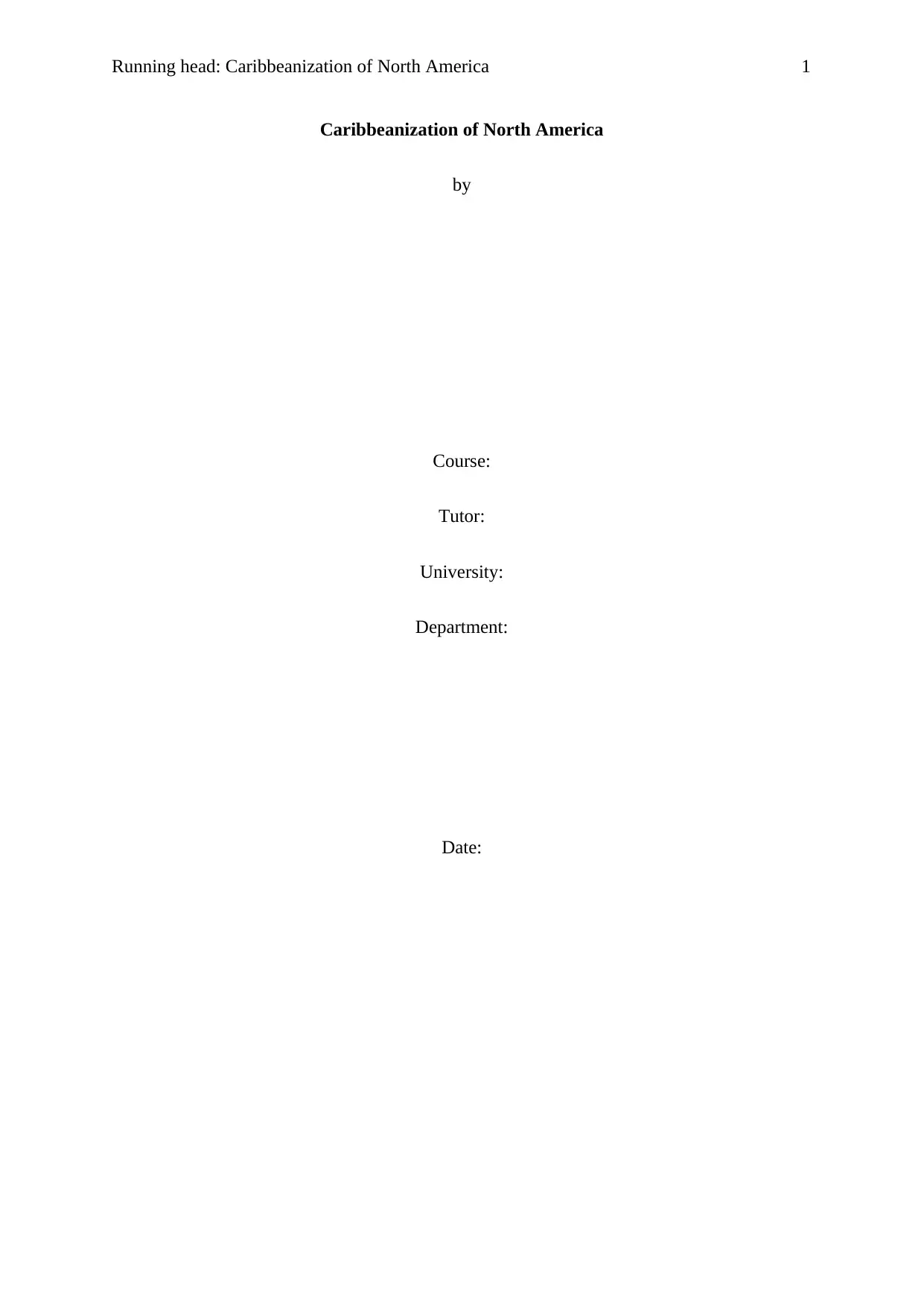
Running head: Caribbeanization of North America 1
Caribbeanization of North America
by
Course:
Tutor:
University:
Department:
Date:
Caribbeanization of North America
by
Course:
Tutor:
University:
Department:
Date:
Paraphrase This Document
Need a fresh take? Get an instant paraphrase of this document with our AI Paraphraser
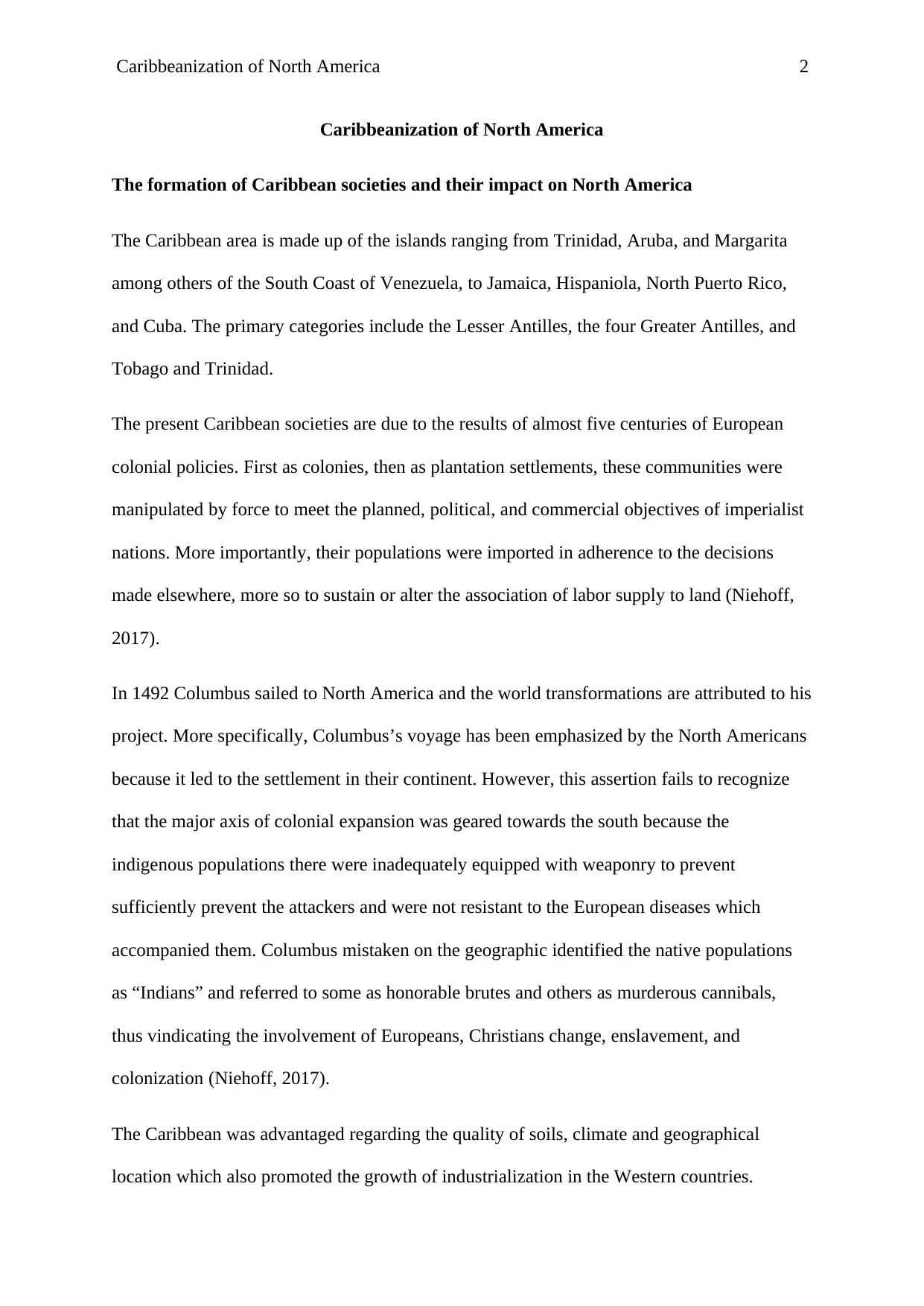
Caribbeanization of North America 2
Caribbeanization of North America
The formation of Caribbean societies and their impact on North America
The Caribbean area is made up of the islands ranging from Trinidad, Aruba, and Margarita
among others of the South Coast of Venezuela, to Jamaica, Hispaniola, North Puerto Rico,
and Cuba. The primary categories include the Lesser Antilles, the four Greater Antilles, and
Tobago and Trinidad.
The present Caribbean societies are due to the results of almost five centuries of European
colonial policies. First as colonies, then as plantation settlements, these communities were
manipulated by force to meet the planned, political, and commercial objectives of imperialist
nations. More importantly, their populations were imported in adherence to the decisions
made elsewhere, more so to sustain or alter the association of labor supply to land (Niehoff,
2017).
In 1492 Columbus sailed to North America and the world transformations are attributed to his
project. More specifically, Columbus’s voyage has been emphasized by the North Americans
because it led to the settlement in their continent. However, this assertion fails to recognize
that the major axis of colonial expansion was geared towards the south because the
indigenous populations there were inadequately equipped with weaponry to prevent
sufficiently prevent the attackers and were not resistant to the European diseases which
accompanied them. Columbus mistaken on the geographic identified the native populations
as “Indians” and referred to some as honorable brutes and others as murderous cannibals,
thus vindicating the involvement of Europeans, Christians change, enslavement, and
colonization (Niehoff, 2017).
The Caribbean was advantaged regarding the quality of soils, climate and geographical
location which also promoted the growth of industrialization in the Western countries.
Caribbeanization of North America
The formation of Caribbean societies and their impact on North America
The Caribbean area is made up of the islands ranging from Trinidad, Aruba, and Margarita
among others of the South Coast of Venezuela, to Jamaica, Hispaniola, North Puerto Rico,
and Cuba. The primary categories include the Lesser Antilles, the four Greater Antilles, and
Tobago and Trinidad.
The present Caribbean societies are due to the results of almost five centuries of European
colonial policies. First as colonies, then as plantation settlements, these communities were
manipulated by force to meet the planned, political, and commercial objectives of imperialist
nations. More importantly, their populations were imported in adherence to the decisions
made elsewhere, more so to sustain or alter the association of labor supply to land (Niehoff,
2017).
In 1492 Columbus sailed to North America and the world transformations are attributed to his
project. More specifically, Columbus’s voyage has been emphasized by the North Americans
because it led to the settlement in their continent. However, this assertion fails to recognize
that the major axis of colonial expansion was geared towards the south because the
indigenous populations there were inadequately equipped with weaponry to prevent
sufficiently prevent the attackers and were not resistant to the European diseases which
accompanied them. Columbus mistaken on the geographic identified the native populations
as “Indians” and referred to some as honorable brutes and others as murderous cannibals,
thus vindicating the involvement of Europeans, Christians change, enslavement, and
colonization (Niehoff, 2017).
The Caribbean was advantaged regarding the quality of soils, climate and geographical
location which also promoted the growth of industrialization in the Western countries.

Caribbeanization of North America 3
Columbus transported the first sugar cane from Spanish Islands to the Caribbean in his
second trip of 1943. He was accompanied by slaves from Africa and Spain. Sugar was first
planted in the Dominican Republic and then exported back to Europe in the 1500s. This
facilitated fast obliteration of the native people, then laborers from Africa were imported as
slaves immediately after the initial plantation of the sugarcanes. This, therefore, cleared the
way for the propagation of the extensive and long-term plantation complex and the fast
revolution of tastes and preferences of Europe.
At least six European powers joined the scramble and fought against each other over the
wealth acquired from the colonized areas. Caribbean islands were exchanged as peace treaties
to seal negotiations after European Wars. Africans were transported as slaves to America, and
40% to the Caribbean alongside agricultural products. “Races” were developed for the
enslavement process and plantation slavery of Africans by Americans. As a result, the
Africans and their descendants became “black” while the Europeans and their descendants
were termed as “white.” This is because of the development of a differential value with
regard to the physical characteristics. Furthermore, this led to the implication of ethnicity in
slave revolts between the European colonists and the Africans, Spanish and French, British or
the Dutch, etc. overall the valorisation of the European culture and “whiteness” in addition to
the depreciation of the Caribbean roots was common in the Caribbean and still is today.
The shift from slavery to freedom led to a period of adjustment for the slaves. However, most
of the ex-slaves went on to work on the plantations but independently as others changed to
peasants. In order to save their returns by reducing the earnings of the ex-slaves, the planters
and the colonial countries introduced the indentured workers from the whole world, and they
stayed in slavery conditions in the Caribbean. The present state in North America of
ethnicity, class competition and wide variation in wealth can equally be seen in the Caribbean
society and are as a result of Caribbeanzation. Additionally, the Caribbean culture, festivals,
Columbus transported the first sugar cane from Spanish Islands to the Caribbean in his
second trip of 1943. He was accompanied by slaves from Africa and Spain. Sugar was first
planted in the Dominican Republic and then exported back to Europe in the 1500s. This
facilitated fast obliteration of the native people, then laborers from Africa were imported as
slaves immediately after the initial plantation of the sugarcanes. This, therefore, cleared the
way for the propagation of the extensive and long-term plantation complex and the fast
revolution of tastes and preferences of Europe.
At least six European powers joined the scramble and fought against each other over the
wealth acquired from the colonized areas. Caribbean islands were exchanged as peace treaties
to seal negotiations after European Wars. Africans were transported as slaves to America, and
40% to the Caribbean alongside agricultural products. “Races” were developed for the
enslavement process and plantation slavery of Africans by Americans. As a result, the
Africans and their descendants became “black” while the Europeans and their descendants
were termed as “white.” This is because of the development of a differential value with
regard to the physical characteristics. Furthermore, this led to the implication of ethnicity in
slave revolts between the European colonists and the Africans, Spanish and French, British or
the Dutch, etc. overall the valorisation of the European culture and “whiteness” in addition to
the depreciation of the Caribbean roots was common in the Caribbean and still is today.
The shift from slavery to freedom led to a period of adjustment for the slaves. However, most
of the ex-slaves went on to work on the plantations but independently as others changed to
peasants. In order to save their returns by reducing the earnings of the ex-slaves, the planters
and the colonial countries introduced the indentured workers from the whole world, and they
stayed in slavery conditions in the Caribbean. The present state in North America of
ethnicity, class competition and wide variation in wealth can equally be seen in the Caribbean
society and are as a result of Caribbeanzation. Additionally, the Caribbean culture, festivals,
⊘ This is a preview!⊘
Do you want full access?
Subscribe today to unlock all pages.

Trusted by 1+ million students worldwide
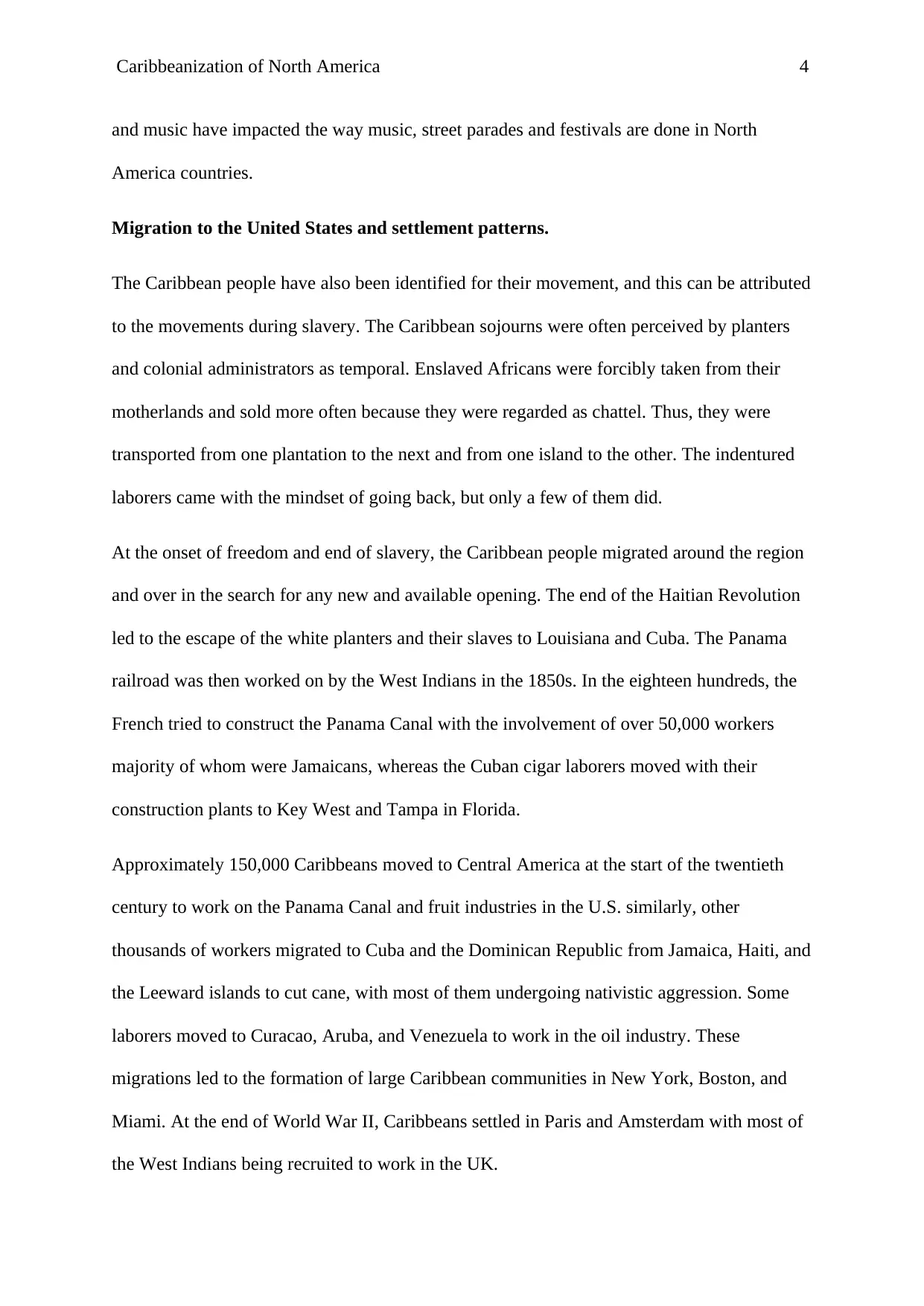
Caribbeanization of North America 4
and music have impacted the way music, street parades and festivals are done in North
America countries.
Migration to the United States and settlement patterns.
The Caribbean people have also been identified for their movement, and this can be attributed
to the movements during slavery. The Caribbean sojourns were often perceived by planters
and colonial administrators as temporal. Enslaved Africans were forcibly taken from their
motherlands and sold more often because they were regarded as chattel. Thus, they were
transported from one plantation to the next and from one island to the other. The indentured
laborers came with the mindset of going back, but only a few of them did.
At the onset of freedom and end of slavery, the Caribbean people migrated around the region
and over in the search for any new and available opening. The end of the Haitian Revolution
led to the escape of the white planters and their slaves to Louisiana and Cuba. The Panama
railroad was then worked on by the West Indians in the 1850s. In the eighteen hundreds, the
French tried to construct the Panama Canal with the involvement of over 50,000 workers
majority of whom were Jamaicans, whereas the Cuban cigar laborers moved with their
construction plants to Key West and Tampa in Florida.
Approximately 150,000 Caribbeans moved to Central America at the start of the twentieth
century to work on the Panama Canal and fruit industries in the U.S. similarly, other
thousands of workers migrated to Cuba and the Dominican Republic from Jamaica, Haiti, and
the Leeward islands to cut cane, with most of them undergoing nativistic aggression. Some
laborers moved to Curacao, Aruba, and Venezuela to work in the oil industry. These
migrations led to the formation of large Caribbean communities in New York, Boston, and
Miami. At the end of World War II, Caribbeans settled in Paris and Amsterdam with most of
the West Indians being recruited to work in the UK.
and music have impacted the way music, street parades and festivals are done in North
America countries.
Migration to the United States and settlement patterns.
The Caribbean people have also been identified for their movement, and this can be attributed
to the movements during slavery. The Caribbean sojourns were often perceived by planters
and colonial administrators as temporal. Enslaved Africans were forcibly taken from their
motherlands and sold more often because they were regarded as chattel. Thus, they were
transported from one plantation to the next and from one island to the other. The indentured
laborers came with the mindset of going back, but only a few of them did.
At the onset of freedom and end of slavery, the Caribbean people migrated around the region
and over in the search for any new and available opening. The end of the Haitian Revolution
led to the escape of the white planters and their slaves to Louisiana and Cuba. The Panama
railroad was then worked on by the West Indians in the 1850s. In the eighteen hundreds, the
French tried to construct the Panama Canal with the involvement of over 50,000 workers
majority of whom were Jamaicans, whereas the Cuban cigar laborers moved with their
construction plants to Key West and Tampa in Florida.
Approximately 150,000 Caribbeans moved to Central America at the start of the twentieth
century to work on the Panama Canal and fruit industries in the U.S. similarly, other
thousands of workers migrated to Cuba and the Dominican Republic from Jamaica, Haiti, and
the Leeward islands to cut cane, with most of them undergoing nativistic aggression. Some
laborers moved to Curacao, Aruba, and Venezuela to work in the oil industry. These
migrations led to the formation of large Caribbean communities in New York, Boston, and
Miami. At the end of World War II, Caribbeans settled in Paris and Amsterdam with most of
the West Indians being recruited to work in the UK.
Paraphrase This Document
Need a fresh take? Get an instant paraphrase of this document with our AI Paraphraser
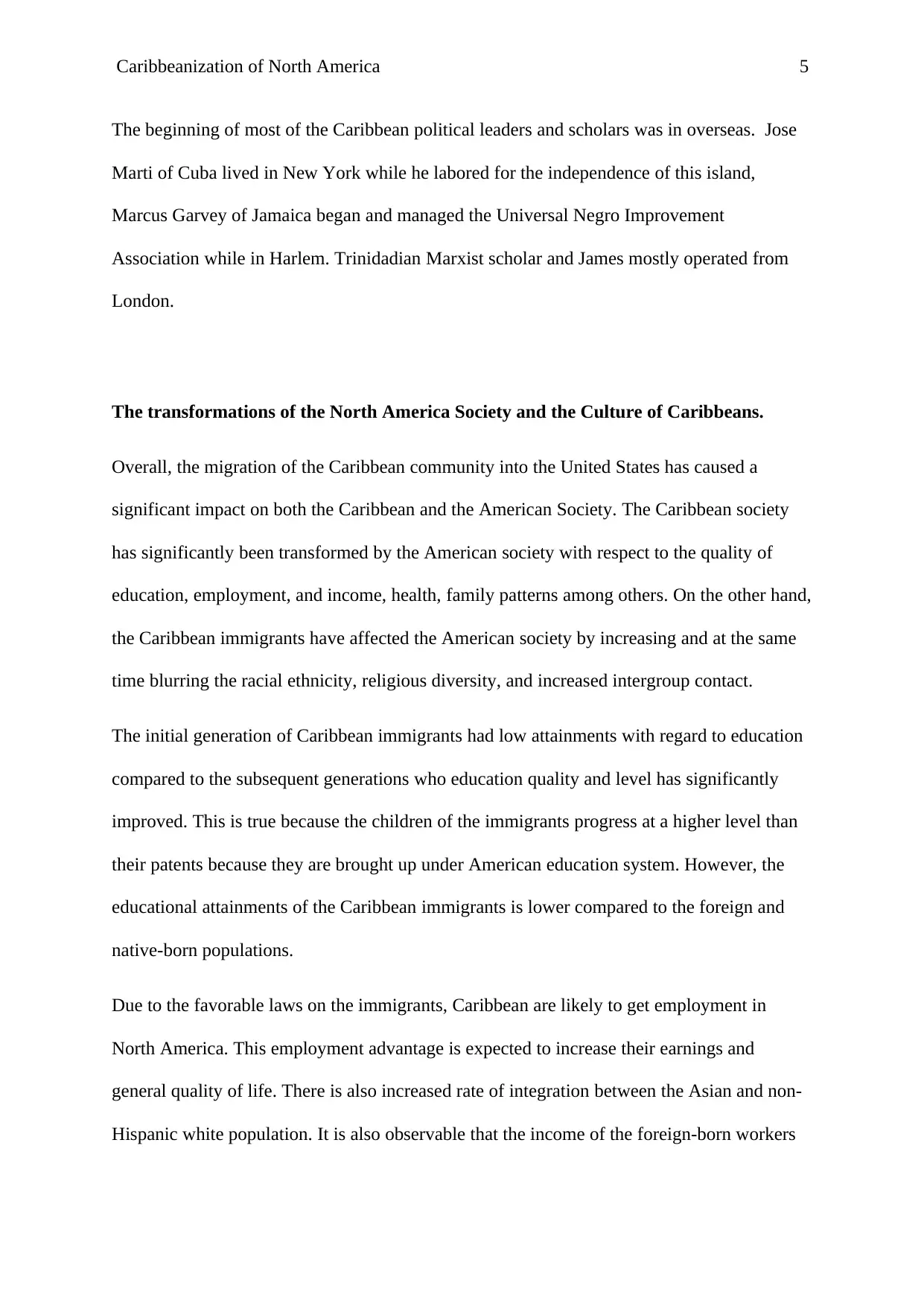
Caribbeanization of North America 5
The beginning of most of the Caribbean political leaders and scholars was in overseas. Jose
Marti of Cuba lived in New York while he labored for the independence of this island,
Marcus Garvey of Jamaica began and managed the Universal Negro Improvement
Association while in Harlem. Trinidadian Marxist scholar and James mostly operated from
London.
The transformations of the North America Society and the Culture of Caribbeans.
Overall, the migration of the Caribbean community into the United States has caused a
significant impact on both the Caribbean and the American Society. The Caribbean society
has significantly been transformed by the American society with respect to the quality of
education, employment, and income, health, family patterns among others. On the other hand,
the Caribbean immigrants have affected the American society by increasing and at the same
time blurring the racial ethnicity, religious diversity, and increased intergroup contact.
The initial generation of Caribbean immigrants had low attainments with regard to education
compared to the subsequent generations who education quality and level has significantly
improved. This is true because the children of the immigrants progress at a higher level than
their patents because they are brought up under American education system. However, the
educational attainments of the Caribbean immigrants is lower compared to the foreign and
native-born populations.
Due to the favorable laws on the immigrants, Caribbean are likely to get employment in
North America. This employment advantage is expected to increase their earnings and
general quality of life. There is also increased rate of integration between the Asian and non-
Hispanic white population. It is also observable that the income of the foreign-born workers
The beginning of most of the Caribbean political leaders and scholars was in overseas. Jose
Marti of Cuba lived in New York while he labored for the independence of this island,
Marcus Garvey of Jamaica began and managed the Universal Negro Improvement
Association while in Harlem. Trinidadian Marxist scholar and James mostly operated from
London.
The transformations of the North America Society and the Culture of Caribbeans.
Overall, the migration of the Caribbean community into the United States has caused a
significant impact on both the Caribbean and the American Society. The Caribbean society
has significantly been transformed by the American society with respect to the quality of
education, employment, and income, health, family patterns among others. On the other hand,
the Caribbean immigrants have affected the American society by increasing and at the same
time blurring the racial ethnicity, religious diversity, and increased intergroup contact.
The initial generation of Caribbean immigrants had low attainments with regard to education
compared to the subsequent generations who education quality and level has significantly
improved. This is true because the children of the immigrants progress at a higher level than
their patents because they are brought up under American education system. However, the
educational attainments of the Caribbean immigrants is lower compared to the foreign and
native-born populations.
Due to the favorable laws on the immigrants, Caribbean are likely to get employment in
North America. This employment advantage is expected to increase their earnings and
general quality of life. There is also increased rate of integration between the Asian and non-
Hispanic white population. It is also observable that the income of the foreign-born workers
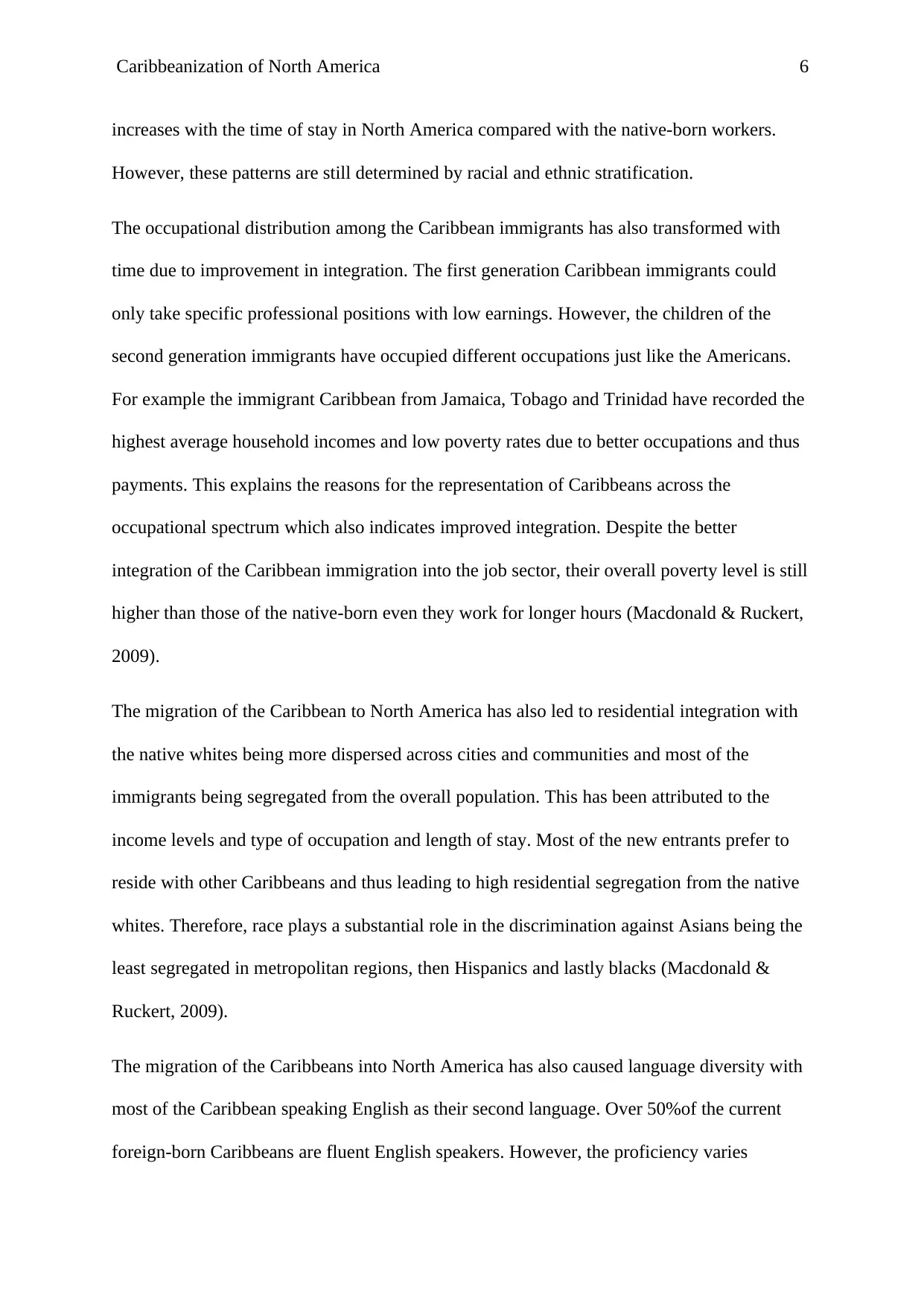
Caribbeanization of North America 6
increases with the time of stay in North America compared with the native-born workers.
However, these patterns are still determined by racial and ethnic stratification.
The occupational distribution among the Caribbean immigrants has also transformed with
time due to improvement in integration. The first generation Caribbean immigrants could
only take specific professional positions with low earnings. However, the children of the
second generation immigrants have occupied different occupations just like the Americans.
For example the immigrant Caribbean from Jamaica, Tobago and Trinidad have recorded the
highest average household incomes and low poverty rates due to better occupations and thus
payments. This explains the reasons for the representation of Caribbeans across the
occupational spectrum which also indicates improved integration. Despite the better
integration of the Caribbean immigration into the job sector, their overall poverty level is still
higher than those of the native-born even they work for longer hours (Macdonald & Ruckert,
2009).
The migration of the Caribbean to North America has also led to residential integration with
the native whites being more dispersed across cities and communities and most of the
immigrants being segregated from the overall population. This has been attributed to the
income levels and type of occupation and length of stay. Most of the new entrants prefer to
reside with other Caribbeans and thus leading to high residential segregation from the native
whites. Therefore, race plays a substantial role in the discrimination against Asians being the
least segregated in metropolitan regions, then Hispanics and lastly blacks (Macdonald &
Ruckert, 2009).
The migration of the Caribbeans into North America has also caused language diversity with
most of the Caribbean speaking English as their second language. Over 50%of the current
foreign-born Caribbeans are fluent English speakers. However, the proficiency varies
increases with the time of stay in North America compared with the native-born workers.
However, these patterns are still determined by racial and ethnic stratification.
The occupational distribution among the Caribbean immigrants has also transformed with
time due to improvement in integration. The first generation Caribbean immigrants could
only take specific professional positions with low earnings. However, the children of the
second generation immigrants have occupied different occupations just like the Americans.
For example the immigrant Caribbean from Jamaica, Tobago and Trinidad have recorded the
highest average household incomes and low poverty rates due to better occupations and thus
payments. This explains the reasons for the representation of Caribbeans across the
occupational spectrum which also indicates improved integration. Despite the better
integration of the Caribbean immigration into the job sector, their overall poverty level is still
higher than those of the native-born even they work for longer hours (Macdonald & Ruckert,
2009).
The migration of the Caribbean to North America has also led to residential integration with
the native whites being more dispersed across cities and communities and most of the
immigrants being segregated from the overall population. This has been attributed to the
income levels and type of occupation and length of stay. Most of the new entrants prefer to
reside with other Caribbeans and thus leading to high residential segregation from the native
whites. Therefore, race plays a substantial role in the discrimination against Asians being the
least segregated in metropolitan regions, then Hispanics and lastly blacks (Macdonald &
Ruckert, 2009).
The migration of the Caribbeans into North America has also caused language diversity with
most of the Caribbean speaking English as their second language. Over 50%of the current
foreign-born Caribbeans are fluent English speakers. However, the proficiency varies
⊘ This is a preview!⊘
Do you want full access?
Subscribe today to unlock all pages.

Trusted by 1+ million students worldwide

Caribbeanization of North America 7
according to region and country of origin. Most of the second generation of Caribbean
immigrants have lost their ancestral language and are speaking English as their first language.
It is also significant to note that the migration of the Caribbeans to North America has also
transformed the culture of North America in different ways. 17% of the U.S population
consists of the Hispanic population with only 62% non-Hispanic, 6%. This is also due to high
birth rates. This integration has reduced the all-white all-black spaces. Despite this
integration, racial segregation is still predominant across the country with the blacks being
the most segregated from the whites, then the Hispanics, Asians, and non-Hispanics.
The Caribbean migration has also brought new religious diversity in North America with
most of the immigrants being Christians. The North American population today has Muslims,
Hindus among others. The Caribbeans have also influenced the shifting patterns of marriage
and intimate relationships between different ethnicities and races. Out of every seven new
unions, there is one that is interracial or interethnic. This is because of the blurring of the
social and cultural boundaries that were clearly defined in the past. The rise of the size of the
mixed-race American is attributed mainly to these intermarriages. The integration of
Caribbeans and their descendants is the primary contributor to caribbeanization of North
America. With time the distinctive features of Americans will become much more blurred
and the Caribbeans are becoming more of Americans through the integration of the
neighborhoods, education institutions, and workplaces and into the families (Macdonald &
Ruckert, 2009).
Conclusion
Caribbeanizaton of North America has progressively been taking place right from the time of
colonization. The Caribbeans were imported as cheap labor during the colonial period, but
after they gained freedom from slavery and of movement, they migrated across the globe in
according to region and country of origin. Most of the second generation of Caribbean
immigrants have lost their ancestral language and are speaking English as their first language.
It is also significant to note that the migration of the Caribbeans to North America has also
transformed the culture of North America in different ways. 17% of the U.S population
consists of the Hispanic population with only 62% non-Hispanic, 6%. This is also due to high
birth rates. This integration has reduced the all-white all-black spaces. Despite this
integration, racial segregation is still predominant across the country with the blacks being
the most segregated from the whites, then the Hispanics, Asians, and non-Hispanics.
The Caribbean migration has also brought new religious diversity in North America with
most of the immigrants being Christians. The North American population today has Muslims,
Hindus among others. The Caribbeans have also influenced the shifting patterns of marriage
and intimate relationships between different ethnicities and races. Out of every seven new
unions, there is one that is interracial or interethnic. This is because of the blurring of the
social and cultural boundaries that were clearly defined in the past. The rise of the size of the
mixed-race American is attributed mainly to these intermarriages. The integration of
Caribbeans and their descendants is the primary contributor to caribbeanization of North
America. With time the distinctive features of Americans will become much more blurred
and the Caribbeans are becoming more of Americans through the integration of the
neighborhoods, education institutions, and workplaces and into the families (Macdonald &
Ruckert, 2009).
Conclusion
Caribbeanizaton of North America has progressively been taking place right from the time of
colonization. The Caribbeans were imported as cheap labor during the colonial period, but
after they gained freedom from slavery and of movement, they migrated across the globe in
Paraphrase This Document
Need a fresh take? Get an instant paraphrase of this document with our AI Paraphraser

Caribbeanization of North America 8
search of better opportunities. Those that got green pastures called for others, and with time
their population and influence has continued to expand to the extent that their culture is
almost merging with that of Americans.
search of better opportunities. Those that got green pastures called for others, and with time
their population and influence has continued to expand to the extent that their culture is
almost merging with that of Americans.

Caribbeanization of North America 9
References
Macdonald, L., & Ruckert, A. (Eds.). (2009). Post-neoliberalism in the Americas. Springer.
Niehoff, A. H. (2017). Caribbean transformations. Routledge.
References
Macdonald, L., & Ruckert, A. (Eds.). (2009). Post-neoliberalism in the Americas. Springer.
Niehoff, A. H. (2017). Caribbean transformations. Routledge.
⊘ This is a preview!⊘
Do you want full access?
Subscribe today to unlock all pages.

Trusted by 1+ million students worldwide
1 out of 9
Related Documents
Your All-in-One AI-Powered Toolkit for Academic Success.
+13062052269
info@desklib.com
Available 24*7 on WhatsApp / Email
![[object Object]](/_next/static/media/star-bottom.7253800d.svg)
Unlock your academic potential
Copyright © 2020–2026 A2Z Services. All Rights Reserved. Developed and managed by ZUCOL.





